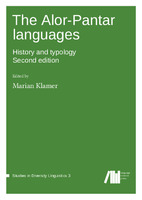The Alor-Pantar languages: History and typology. Second edition.
| dc.contributor.editor | Klamer, Marian | |
| dc.date.accessioned | 2017-05-01 23:55:55 | |
| dc.date.accessioned | 2018-12-12 10:19:03 | |
| dc.date.accessioned | 2020-04-01T13:31:11Z | |
| dc.date.available | 2020-04-01T13:31:11Z | |
| dc.date.issued | 2017 | |
| dc.identifier | 631252 | |
| dc.identifier | OCN: 1030820272 | en_US |
| dc.identifier.issn | 2363-5568 | |
| dc.identifier.uri | http://library.oapen.org/handle/20.500.12657/31330 | |
| dc.description.abstract | "The Alor-Pantar family constitutes the westernmost outlier group of Papuan (Non-Austronesian) languages. Its twenty or so languages are spoken on the islands of Alor and Pantar, located just north of Timor, in eastern Indonesia. Together with the Papuan languages of Timor, they make up the Timor-Alor-Pantar family. The languages average 5,000 speakers and are under pressure from the local Malay variety as well as the national language, Indonesian. This volume studies the internal and external linguistic history of this interesting group, and showcases some of its unique typological features, such as the preference to index the transitive patient-like argument on the verb but not the agent-like one; the extreme variety in morphological alignment patterns; the use of plural number words; the existence of quinary numeral systems; the elaborate spatial deictic systems involving an elevation component; and the great variation exhibited in their kinship systems. Unlike many other Papuan languages, Alor-Pantar languages do not exhibit clause-chaining, do not have switch reference systems, never suffix subject indexes to verbs, do not mark gender, but do encode clusivity in their pronominal systems. Indeed, apart from a broadly similar head-final syntactic profile, there is little else that the Alor-Pantar languages share with Papuan languages spoken in other regions. While all of them show some traces of contact with Austronesian languages, in general, borrowing from Austronesian has not been intense, and contact with Malay and Indonesian is a relatively recent phenomenon in most of the Alor-Pantar region." | |
| dc.language | English | |
| dc.relation.ispartofseries | Studies in Diversity Linguistics | |
| dc.subject.classification | thema EDItEUR::C Language and Linguistics::CF Linguistics | en_US |
| dc.subject.other | elevationals | |
| dc.subject.other | alor-pantar languages | |
| dc.subject.other | comparative linguistics | |
| dc.subject.other | papuan languages | |
| dc.subject.other | linguistics typology | |
| dc.subject.other | numeral systems | |
| dc.subject.other | Abui language | |
| dc.subject.other | Adang language | |
| dc.subject.other | Alor–Pantar languages | |
| dc.subject.other | Blagar language | |
| dc.subject.other | Parallel and cross cousins | |
| dc.subject.other | Teiwa language | |
| dc.subject.other | Wersing language | |
| dc.subject.other | Western Pantar language | |
| dc.subject.other | Woisika language | |
| dc.title | The Alor-Pantar languages: History and typology. Second edition. | |
| dc.type | book | |
| oapen.identifier.doi | 10.5281/zenodo.437098 | |
| oapen.relation.isPublishedBy | 0bad921f-3055-43b9-a9f1-ea5b2d949173 | |
| oapen.relation.isFundedBy | b818ba9d-2dd9-4fd7-a364-7f305aef7ee9 | * |
| oapen.relation.isbn | 9783946234678;9783946234913 | |
| oapen.collection | Knowledge Unlatched (KU) | * |
| oapen.series.number | 3 | |
| oapen.pages | 461 | |
| oapen.remark.public | Relevant Wikipedia pages: Abui language - https://en.wikipedia.org/wiki/Abui_language; Adang language - https://en.wikipedia.org/wiki/Adang_language; Alor–Pantar languages - https://en.wikipedia.org/wiki/Alor%E2%80%93Pantar_languages; Blagar language - https://en.wikipedia.org/wiki/Blagar_language; Pantar - https://en.wikipedia.org/wiki/Pantar; Parallel and cross cousins - https://en.wikipedia.org/wiki/Parallel_and_cross_cousins; Teiwa language - https://en.wikipedia.org/wiki/Teiwa_language; Wersing language - https://en.wikipedia.org/wiki/Wersing_language; Western Pantar language - https://en.wikipedia.org/wiki/Western_Pantar_language; Woisika language - https://en.wikipedia.org/wiki/Woisika_language | |
| oapen.identifier.ocn | 1030820272 |

